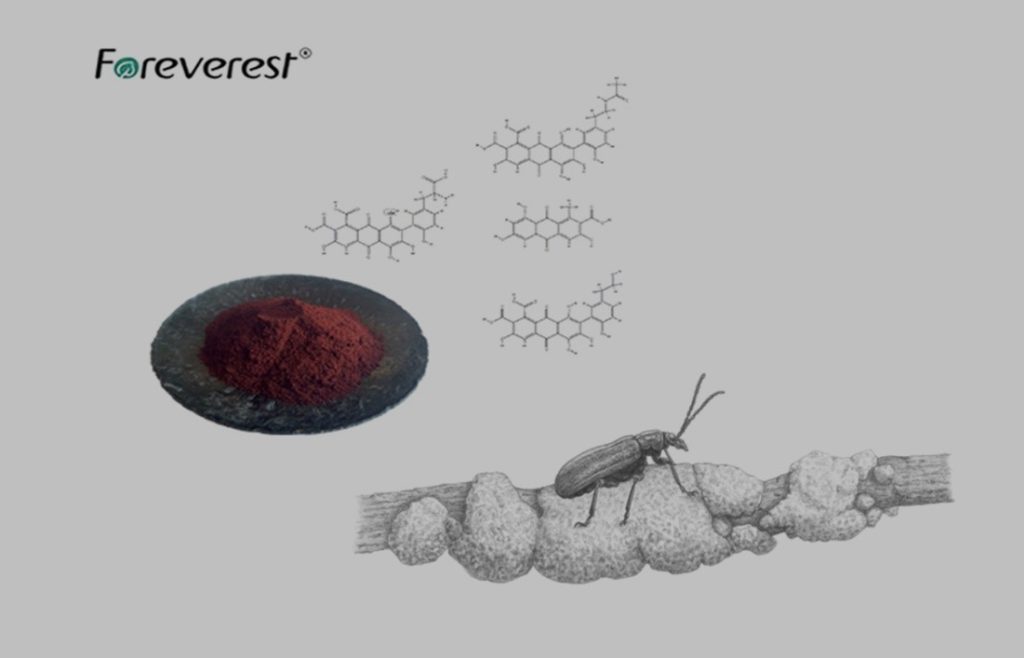Adhesives & Sealants & Tackifiers, R&D, Coatings, Cosmetics & Persnoal Cares, Pharmaceutical
Fate of Kerria Lacca, the Lac Insect

Adhesives & Sealants & Tackifiers, R&D, Coatings, Cosmetics & Persnoal Cares, Pharmaceutical

For many ordinary people, the coloring agent was a rejected additive for food and cosmetic due to the stereotype for artificial pigment. In fact, before the synthetic method was found, food coloring agent extracted from plant and insect is widely used. The representative pigment of insect origin is lac dye that has been used for thousands of years. Lac dye comes from shellac, which is also initially produced by the insect called Kerria Lacca. For health and safety reasons, the pigment, along with its raw material, has regained popularity in recent years.
Kerria Lacca is a tiny red insect lives on more than 400 host plants, mainly on trees such as Palas (Butea monosperma), Kusum (Schleichera oleosa), and Ber (Ziziphus mauritiana) native to India and Thailand, where it sucks sap from the twigs during the breeding cycle and excretes an amber-colored, resinous substance known as shellac. It was then called by the local people as “lakh” in Sanskrit word, which means hundreds and thousands referring to vast swarms of insect larvae that inundate lac trees during brood season. It is the enormous amount that makes the natural color synthetic possible. According to the statistic, it takes about 17000 to 90000 insects to produce only one pound of shellac.
The Destiny of Kerria Lacca
As other insects, shellac actually plays a role as a protective cocoon for Kerria Lacca. The whole life cycle of the insect spans six months and is devoted to eating, propagating and creating lac. While it eats it propagates. A female insect is the main producer, with each female producing about one thousand eggs before dying. In the body of the insect, the digested tree sap undergoes a chemical transformation and is eventually secreted through pores. Once contacting with air, it forms a hard shell-like covering over the entire swarm. In time this covering becomes a composite crust for the twig and insects. Now Kerria Lacca is an important economic insect raised for harvesting lac dye and shellac.
History of Lac Dye and Shellac Use
The sticklac is scraped off the tree by hand, washed and then refined either chemically or by hand, to produce the raw material available for sale to commerce. This initial product is called shellac. The main components of shellac are shellac resin, shellac pigment and shellac wax, in addition, there are a few impurities, such as sugar, salt, protein, insect corpse. After initial filtration, seedlac can be gained. The seedlac is further refined to produce high quality shellac. Although shellac has the distinction of being the only known commercial resin of animal origin, it was at first harvested for lac dye. The pigment is chemically classified as anthraquinones extracted from dried gravid insects using boiling water. The history of its application can be traced back to ancient times when the Indian and Chinese people used it to color leather, wool and silk or as facial and head decoration. Fallowing the world trade in 13th century, lac dye traveled to Europe and found its larger value there. At that time, both lac dye and shellac were used in painting, decorating and finishing. Until the 1800s, this dye remained an expensive commodity from the oriental world. After Perkins, an English chemist who successfully synthesized the first chemical ‘aniline’ dyes, the natural dye industry was almost ruined. However, the contribution from these insects is not done in vain. The importance of shellac as the finish has been introduced to America since then, when the largest shellac supplier Zinseer was established, indicating a new start for Kerria Lacca products.
Modern Application of Lac Dye and Shellac
Enduring the impact of substitute artificial products, natural shellac and lac dye is still active in the industry with the benefits of low toxicity in use. According to the data from Zinseer, the top 3 uses for the shellac flakes are pharmaceutical, confectionery and food coatings which are irreplaceable.
In pharmaceutical, compared to the synthetic material used in wrapping the pills, shellac is safer to coat enteric pills, protecting them from being dissolved in the stomach and reach the lower intestine, where they should take effect. In confectionery and food production, shellac is used as candy and fresh fruit coating to provide special gloss and to increase their shelf life because it forms a membrane to inhibit respiration during transportation and storage. For electrical products, shellac is mixed with marble dust and applied in lamp manufacturers to glue the metal base to glass incandescent bulbs. It also finds its use in painting and polishing.
Though the emergence of some more durable resins accelerates its obsolescence, ironically, scientists are still fighting to duplicate this kind of natural resin produced by Kerria Lacca for its superior property, recognizing the hard work of this little creature.